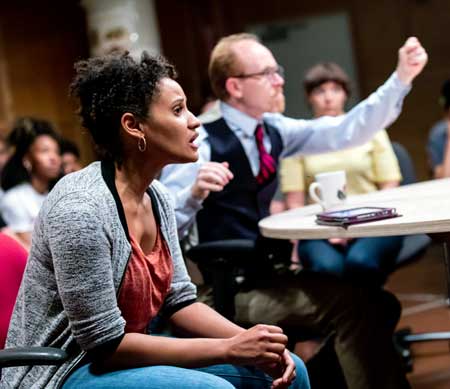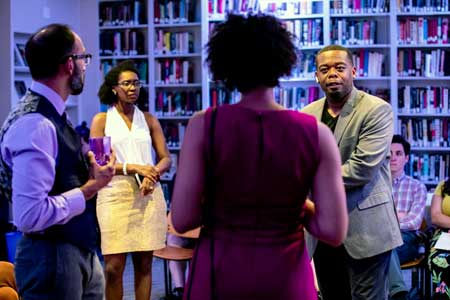Play
by Kirsten Greenidge
Directed by Steven Bogart
Company One Theater
in collaboration with
American Repertory Theater
Commonwealth School
Commonwealth Avenue, Boston
July 17 – August 17, 2019
Scenic Designer: Cristina Todesco; Dramaturg: Ilana M. Brownstein; Stage Manager: Ashmita Malkani
With Dev Blair (Kyle), Dominic Carter (Michael), Blyss Cleveland (Kim), Rachel Cognata (Christine/Ann), Shahjeshan Khan (Adams), Becca A. Lewis (Fern), Raijene Murchison (Isa), Christine Power (Val), Brooks Reeves (Gordon), Ruv Chigwedere (Agent), Ece Hakim (Agent), Alexandra Jeffay (Agent), Genevieve Lefevre (Agent), Chloe Levine (Agent), Eli Troen (Agent)

Brooks Reeves as Gordon
in “Greater Good”
Photo:Natasha Moustache
Courtesy of Company One Theater and American Repertory Theater
There is trouble afoot at the Gleason Street School. The headmaster, Gordon (Brooks Reeves), is a well-meaning administrative incompetent who has his values right but his leadership attentions wrong. Surrounding him are a parent board that is challenged and dumbfounded by the financial distresses of the school but gripped by the school’s mission.
You have to hand it to these guys at CompanyOne and the ART for creating an almost three-hour long dramatic travelogue throughout the Commonwealth School that coordinates scenes for four different groups of audience members at a time. It’s a competent and energetic example of dramatic stage choreography which enables such a feat to be pulled off at all.
The drama this major effort conveys is well-meaning and heartfelt even if, during much of its delineation, there is more chest-thumping than nuanced dramatic elaboration. There are indeed wonderful moments and some great acting, and the theme is a touching and potent one, but the narrative is of somewhat limited scope and the effect of rambling around the school, though kind of fun, does not particularly contribute to enhancing the drama itself.
When Diane Paulus first came to the ART ten years ago, she mounted an immediately potent hit, Sleep No More, in an abandoned school in Brookline, along many of the same principles. There, instead of being led from room to room by a team of audience guides as is done in Greater Good, wandering was allowed. By vagabonding through the school and hitting on all the available scenes, one eventually got the drift of the narrative, or enough of it to have an evening’s worth of adventurous entertainment.
Here the ruse is that the school building in which this private elementary school had been housed is up for sale due to the financial befuddlement described above. So, every time the audience is prompted to move from one room to another – and it happens a lot – a cute audience guide playing a real estate agent goes on about the beautiful decor. It’s a cute gag and though it fits into the drama at the very end, it’s repeated so many times it gets a bit old.
In addition to the space of the play being all over the place, the narrative is somewhat dispersed as well. The general drift of it is about the desirability of private school for all people, including those who are less economically able to sustain it, and the problems private schools have sustaining themselves. Throw in a bit of indignant attitude by a trans teacher who can’t get a raise, an undermining affair between school administrators, and, present throughout, the general issues of racism and economic disparity, and you have the rough outline of this dramatic landscape.

Blyss Cleveland as Kim
Rachel Cognata as Christine
Dominic Carter as Michael
in “Greater Good”
Photo:Natasha Moustache
Courtesy of Company One Theater and American Repertory Theater
There are indeed beautifully written scenes and some wonderful performances.
Perhaps the most memorable of these is given by Rachel Cognata as Christine when she, as a person of color and a parent of a child at the school, is shown filming a video advertisement for the school experience. The short speech she gives is a wonderful evocation of the reasons that people seek out such education and why she in particular as the mother of a child of color would want an environment that stresses the child’s mental, emotional and creative energies and does not just typecast him as a potential sports success. Cognata’s performance in this scene is particularly nuanced and compelling, and her strong and evocative performance throughout provides the heartbeat of the show. Cognata does have a quite different second role, as Ann, in which she enters at the end and she pulls this off, as well, with considerable distinction from her role as Christine and, again, very effectively.
Other actors turn in very good performances as well.
Blyss Cleveland plays Kim, a wealthy and high-class woman of color who is on the school’s board. Her stage demeanor in this role has a perfect hauteur, with a crisply intense and defiantly but appealingly aristocratic disposition that makes one think of Katherine Hepburn.
Brooks Reeves as Gordon, the befuddled and incompetent but lovably idealistic and goofy headmaster, has a compelling charm that rings true right alongside his vivid liabilities. He plays the perfect leader and the perfectly incapable one, all in one fell swoop.
As Kyle, the trans teacher who can’t get a break, Dev Blair offers a memorably militant performance which conveys with its disposition of beard, breasts and dreadlocks, all the vulnerabilities of being a trans employee passionately connected to their work but subject to the social disenfranchisement that position can easily bring with it.
A set of other good performances round out the production nicely. Shahjehan Khan, as Adams, a board member, is pointed and intense. Raijene Murchison, as Isa, is playfully wild. Dominic Carter, as Michael, a software entrepreneur, is paradoxically both impassioned and aloof. Becca A. Lewis, as Fern, is, effectively, alternately wimpy and forthright, and Christine Power, as Val, is indeed the power behind the throne, playing it for keeps on both sides of the aisle with a creepily curious disposition.
I’m not sure that the concern focused on a private school can generate as much indignation and powerful responsiveness as the play intends. The main underlying forces driving the drama are racism and economic divergence, but the context of private elementary education does not immediately call up social ardor.
The play’s long view – that better management of such private organizations by the disenfranchised, along with generosity from a broader public might bring greater good to such situations – is well-taken but does not exactly call forth the passions of a social revolution. Within its domain it’s a nice thought, but really the passion in the direction of support for public education more readily reinforces these kinds of creative and thoughtful energies. Public education barely gets mentioned in the play except as an undesirable alternative to private education. I’m not sure why. It seems as though the drama might have been that much more effective if its setting were in that space rather than in the lap of privilege.
– BADMan
Leave a Reply